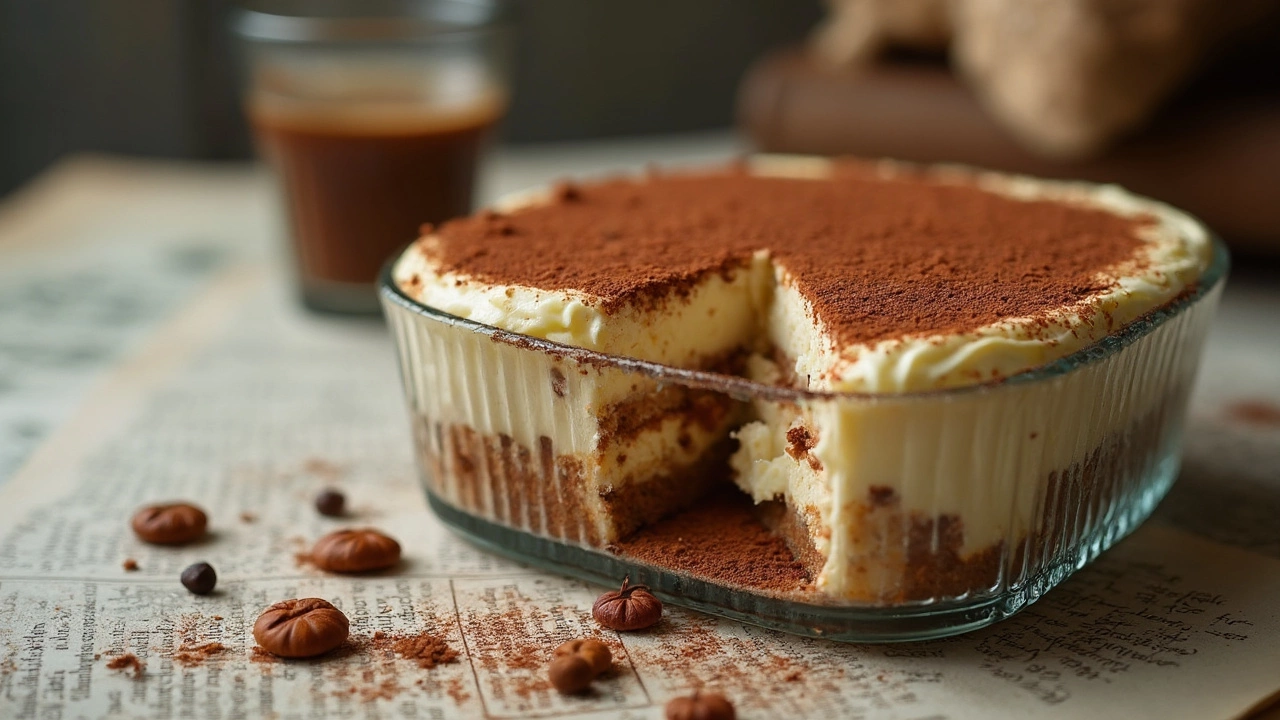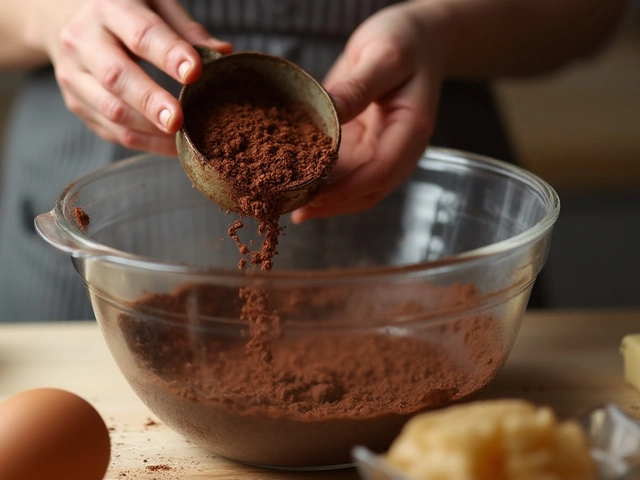Tiramisu isn’t just another Italian dessert—it’s the one everyone tries to copy, but few actually get right. Some restaurants just toss together random layers and call it ‘tiramisu,’ but there’s a reason the real thing hits different. If you’ve ever wondered which sobremesa Italians actually invented that took off worldwide, this is the one.
Tiramisu is all about layers: coffee-soaked ladyfingers, creamy mascarpone cheese, a dusting of cocoa powder, and usually a splash of booze if you’re feeling bold. It’s not an ancient Italian tradition, though. Tiramisu showed up way later than classics like panna cotta or cannoli, but it shot to fame insanely fast. Why? It looks fancy, tastes even better, and you don’t need to be a pastry chef to whip it up at home.
- How Tiramisu Came to Be
- What Makes Tiramisu Special
- Nailing the Classic Tiramisu at Home
- Tiramisu’s Place in Modern Food Culture
How Tiramisu Came to Be
Plenty of people think tiramisu has been around as long as pizza, but it’s actually pretty new in the world of Italian desserts. The earliest confirmed mention pops up in the late 1960s in the region of Veneto, northern Italy. That’s much later than classic Italian sweets like gelato or biscotti. The town most often credited for inventing tiramisu is Treviso, where a restaurant called Le Beccherie claims to have put it on the menu first around 1970.
According to family stories from Le Beccherie, a pastry chef named Roberto Linguanotto worked with Ada Campeol and her husband to create that first creamy, boozy, and coffee-soaked dessert. Weird thing? There’s no record of tiramisu in cookbooks before then—so, no, your great-great-nonna wasn’t serving up tiramisu in the 1800s.
The name tiramisu literally means “pick me up” in Italian. Makes sense when you realize how much espresso and sugar go into each bite. There are even arguments about whether the original had alcohol. Some say Marsala wine was always a must, others swear it was kid-friendly from the start. But either way, the main idea was to serve a sweet that felt like a little boost at the end of a meal—practically Italy’s answer to an energy drink for the soul.
Here’s the real kicker: tiramisu went global almost overnight. By the 1980s, American restaurants started offering it as a signature dessert, and now you’ll find it everywhere from small cafés to fancy hotels, with people constantly coming up with crazy spins on the original.
What Makes Tiramisu Special
So many desserts try to impress with complicated steps or crazy ingredients, but tiramisu stands out because it’s dead simple while still feeling like a treat. The heart of tiramisu is a perfect balance: strong espresso-soaked ladyfingers, creamy layers of mascarpone fluff, and just the right kick from cocoa—and sometimes a hint of booze. Unlike cakes that need precise baking, tiramisu is a no-bake deal, so you can pull it off even without fancy equipment.
One thing that really separates tiramisu from other sweets is its texture. The ladyfingers go soft but never mushy, and that mascarpone layer gives you a creamy mouthful that doesn’t feel heavy. This combo is hard to beat and is the main reason people never get bored of tiramisu.
Another cool fact: tiramisu wasn’t part of "old school" Italian desserts until the 1970s. That’s when it popped up in Treviso, and local chefs started tweaking recipes. Fast forward, and now it’s on just about every Italian menu in the world. Check out these numbers showing how fast tiramisu took over:
| Year | Major Milestone |
|---|---|
| 1972 | First tiramisu appears in Treviso, Veneto region |
| 1985 | Becomes a menu staple in Northern Italian restaurants |
| 1990s | Goes global—turns up in the U.S. and all over Europe |
| 2020 | Ranked among most-searched desserts online worldwide |
Italians love to keep tiramisu classic, but if you look around, there are so many spinoffs—think strawberry tiramisu, matcha tiramisu, even vegan options. The base is always pretty much the same, though, and that's what people keep coming back for. If you want to nail the real tiramisu experience, focus on good espresso, fresh mascarpone, and never skip the cocoa dusting. That’s how you get that cloud-like texture and coffee punch everyone raves about.

Nailing the Classic Tiramisu at Home
If you want to impress friends or just treat yourself, tiramisu is surprisingly doable—no fancy oven tricks, no oddball ingredients. Just stick to the basics and don't overthink it.
First, get the real stuff: Italian ladyfingers (savoiardi), mascarpone cheese, strong coffee (preferably espresso), fresh eggs, sugar, unsweetened cocoa powder, and a little Marsala or a splash of some coffee liqueur if you like a grown-up kick. Don’t substitute with whipped cream or cream cheese. That shortcut ruins what makes tiramisu special.
- Brew your coffee. Let it cool a bit—you don’t want soggy, falling-apart ladyfingers.
- Mix your mascarpone cream. Whip egg yolks with sugar until pale, fold in mascarpone, then gently add whipped egg whites (skip the egg whites if you’re nervous about raw eggs or use pasteurized eggs).
- Layer it up. Dip ladyfingers quickly in coffee (don’t soak!), then arrange them in your dish. Add a layer of mascarpone cream. Repeat.
- Chill for at least 4 hours—overnight is best. The flavors blend and those famous creamy, boozy layers appear.
- Dust with cocoa right before serving. Not beforehand, unless you like damp cocoa mud on top.
Here’s a quick cheat sheet for classic tiramisu:
| Ingredient | Amount |
|---|---|
| Ladyfingers | 200g (about 24 pieces) |
| Mascarpone | 500g |
| Egg yolks | 4 |
| Sugar | 100g |
| Espresso | 300ml (cooled) |
| Marsala (optional) | 2-3 tbsp |
| Unsweetened cocoa | 2 tbsp |
A helpful tip: always use a glass or ceramic dish so you can see those mouth-watering layers. And if you’re prepping ahead, tiramisu keeps its texture for a couple of days in the fridge. It usually vanishes faster—the record in my house is breakfast the next morning, thanks to Leonard’s midnight snack habit. You don’t need to tell anyone it’s leftover-friendly, but you’ll know.
Tiramisu’s Place in Modern Food Culture
People all over the world crave tiramisu. In cafés, bakeries, and even fast food joints from Milan to Tokyo, you’ll spot some form of this layered treat. Not bad for a dessert that only popped up in the 1960s in Treviso, Italy. It quickly went from local favorite to global superstar. In Italy, tiramisu even has its own official day—March 21—which is kind of a big deal for a dessert that’s younger than a lot of pop songs.
Tiramisu isn’t just sticking to the classics either; chefs are always finding new ways to serve it. Ever tried tiramisu pancakes? Or ice cream? Restaurants love to riff on the original recipe, so you’ll find creative versions everywhere. Supermarkets in Europe and the US now sell ready-to-eat tiramisu, making it easy for anyone to grab a taste of Italy without leaving home.
It’s also one of the most searched-for desserts online every year. People search for tips on perfecting mascarpone or swapping in whatever coffee they’ve got at home. Apps like Instagram are packed with mouthwatering tiramisu shots; foodies are turning the humble sobremesa into a total influencer.
| Country | Average Annual Google Searches for 'Tiramisu' |
|---|---|
| Italy | 500,000+ |
| United States | 1,100,000+ |
| Brazil | 440,000+ |
| Japan | 360,000+ |
| UK | 210,000+ |
Here’s why tiramisu keeps winning hearts everywhere:
- It’s easy to make ahead—perfect for parties.
- No baking needed (soaring oven temps in summer? No thanks!).
- It blends the best things: coffee kick, creamy texture, and just enough sweetness.
- You can tweak the recipe to fit diets—think gluten-free ladyfingers or dairy-free mascarpone swaps.
If you walk into any Italian restaurant (even outside Italy) and tiramisu isn’t on the dessert menu, it just feels like something’s missing. That’s how strongly it defines the category.





